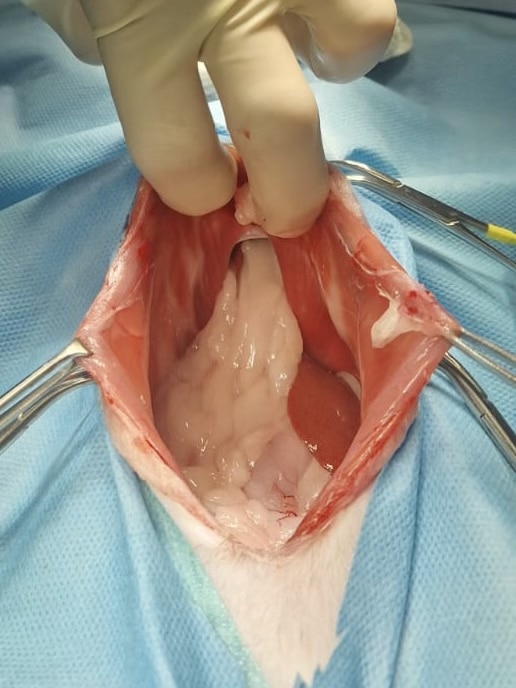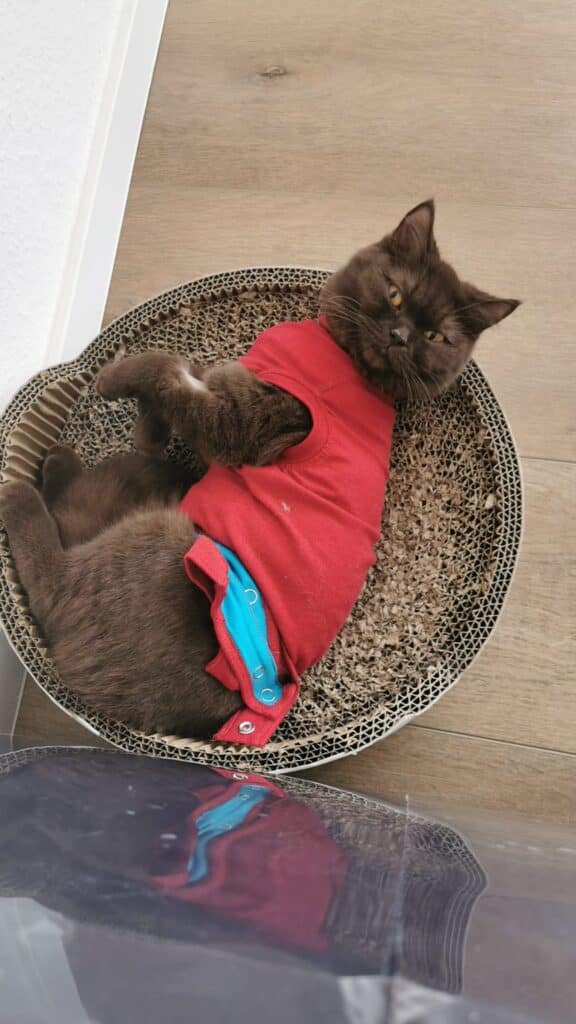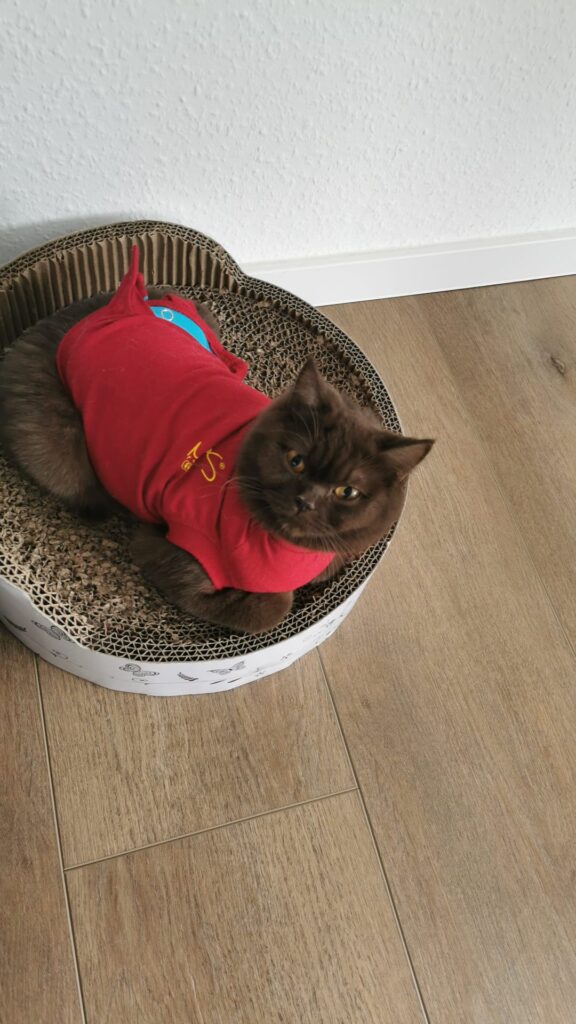Peritoneopericardial diaphragmatic hernia in cats: A comprehensive guide
- Peritoneopericardial diaphragmatic hernia in cats: A comprehensive guide
- introduction
- etiology
- Pathogenesis
- Clinical signs
- Diagnosis
- Treatment of peritoneopericardial diaphragmatic hernia
- Peritoneopericardial diaphragmatic hernia (PPDH) surgical procedure
- Potential complications of peritoneopericardial diaphragmatic hernia
- Prognosis for peritoneopericardial diaphragmatic hernia
- Prevention and risk factors for peritoneopericardial diaphragmatic hernia
- Frequently asked questions (FAQ) about peritoneopericardial diaphragmatic hernia (PPDH) in cats
- Summary peritoneopericardial diaphragmatic hernia
introduction
We had an exciting case this week - Emma was supposed to be castrated and during the preliminary examination this complication turned out to be that she had a peritoneopericardial diaphragmatic hernia (PPDH).
Peritoneopericardial diaphragmatic hernia (PPDH) is a rare malformation in cats in which there is an open connection between the pleuroperitoneal membrane and the pericardium. This abnormality causes organs to protrude from the abdominal cavity into the pericardium. Below we will explain the etiology, pathogenesis, clinical signs, diagnosis and therapy of this disease in more detail.
For the layman, a peritoneopericardial diaphragmatic hernia (PPDH) is a rare malformation in cats in which there is an opening between the abdominal and thoracic cavities. This can cause organs from the abdomen to enter the pericardium, which can lead to problems with heart function. Most affected cats show no symptoms, while others may have difficulty breathing or pain. Diagnosis is made through imaging tests and in some cases surgical treatment is necessary.
Peritoneopericardial diaphragmatic hernia (PPDH) more commonly affects long-haired cats, particularly Persian cats and Maine Coon cats. However, it is important to note that this condition can also occur in other cat breeds, although less frequently.
etiology
Although the exact cause of PPDH is not known, it is believed to be a spontaneous malformation with no familial history. This disease mainly affects long-haired cats such as Persians and Maine Coons, although there are no known gender predispositions.
Pathogenesis
In PPDH, an open connection occurs between the pleuroperitoneal membrane and the pericardium, allowing organs to protrude from the abdominal cavity into the pericardium. This can cause compression of the heart and possible impairment of cardiac function.
Clinical signs
In most cases this is an incidental finding as the affected animals are often asymptomatic. However, some cats may exhibit nonspecific clinical signs such as tachypnea (rapid breathing), dyspnea (shortness of breath), and pain. In contrast to dogs, cats rarely experience gastrointestinal symptoms.
Diagnosis
The diagnosis of PPDH can usually be made using a combination of auscultation, x-ray and echocardiography. Auscultation may reveal weakened heart sounds and possibly borborygmas (intestinal murmurs) if intestinal loops have prolapsed into the pericardium. A chest x-ray typically shows an enlarged cardiac silhouette. A more detailed examination using echocardiography can confirm the diagnosis, as organs in the pericardium can be easily identified.
Treatment of peritoneopericardial diaphragmatic hernia
If symptoms are clinically evident or cardiac function is impaired, surgical intervention should be considered. Asymptomatic patients do not necessarily need surgery, but regular ultrasonographic checks should be carried out in order to detect possible complications at an early stage.
Peritoneopericardial diaphragmatic hernia (PPDH) surgical procedure
The surgical procedure for a peritoneopericardial diaphragmatic hernia (PPDH) aims to relocate the prolapsed organs back into the abdominal cavity and to close the open connection between the pleuroperitoneal membrane and the pericardium. The surgical procedure is explained in several steps below.
Preparation for peritoneopericardial diaphragmatic hernia
Before the procedure, the cat undergoes a thorough examination and diagnostics to determine the exact location and extent of the hernia. The cat is kept fasting to reduce the risk of aspiration during anesthesia. It is important to carefully monitor the cat's cardiac function and general condition before inducing anesthesia.
Anesthesia and positioning
The cat is placed under general anesthesia to prevent pain during the procedure and to ensure adequate muscle relaxation. The positioning of the cat on the operating table depends on the exact location of the hernia. The cat is usually positioned on its back to allow optimal access to the chest and abdominal cavity.
Surgical approach for peritoneopericardial diaphragmatic hernia
Access to the surgical site is through a median abdominal incision (laparotomy) or through a thoracotomy, depending on the location of the hernia and the surgeon's preference. A laparotomy involves making a longitudinal incision along the midline of the abdomen, while a thoracotomy uses a lateral approach to the chest.
Repositioning of the organs
After the surgical area is exposed, the prolapsed organs are carefully examined to ensure there are no injuries or circulatory problems. The organs are then carefully moved back into the abdominal cavity. In some cases, adhesions or adhesions must be released to return the organs to the correct position.

Closure of the hernia
After the organs have been reduced, the open connection between the pleuroperitoneal membrane and the pericardium is closed. This can be done by direct suture of the defect, use of synthetic mesh, or muscle wrapplasty, depending on the size of the hernia and the surgeon's preference. The suture materials should be non-absorbable to ensure long-term stabilization of the repaired structures.
Completion of the operation
After the hernia has been closed, the abdominal or thoracic walls are closed in layers, with particular attention being paid to the careful adaptation of the different tissue layers. The skin is closed with a cosmetically pleasing suture. After the procedure, a bandage will be applied to help the wound heal and prevent infection.
Postoperative care and aftercare for peritoneopericardial diaphragmatic hernia
The cat will be woken up in a warm, quiet room after surgery to minimize stress and promote rapid recovery from anesthesia. The cat's cardiac and respiratory function, body temperature and general condition are closely monitored in order to identify possible complications at an early stage.
Pain management is an essential part of postoperative care. Analgesics are administered according to the cat's individual needs and pain intensity to reduce pain and promote the healing process.
Antibiotic therapy may be prescribed if necessary to prevent or treat infections. It is important that the cat owner administer the medication according to the veterinarian's instructions and monitor for possible signs of complications.
The stitches or staples are usually removed 10 to 14 days after surgery, provided the wound has healed well. Regular follow-up visits to the vet are necessary to monitor the healing process and assess the cat's heart function. In some cases, long-term follow-up with ultrasound scans of the heart may be necessary to ensure there are no recurrences or complications.
Potential complications of peritoneopericardial diaphragmatic hernia
As with any surgical procedure, there is some risk of complications when treating a peritoneopericardial diaphragmatic hernia. These include bleeding, infection, suture dehiscence (opening of the suture), and injury to nearby organs or structures during the procedure. In rare cases, the hernia can recur, especially if the closure suture is not sufficiently stable.
In order to minimize the risk of complications, it is important that the operation is carried out by an experienced animal surgeon (in our case by Ms. Arndt & Martins) and that the cat undergoes careful postoperative care and aftercare.
Prognosis for peritoneopericardial diaphragmatic hernia
The prognosis for cats with hemodynamically irrelevant hernias or after successful surgical intervention is considered to be very good. Nevertheless, regular follow-up care should be ensured in order to identify and treat possible later complications at an early stage.


Picture: Emma shortly after the operation
Prevention and risk factors for peritoneopericardial diaphragmatic hernia
Since the exact cause of PPDH is not known, there are currently no specific prevention measures. However, breeders and cat owners should pay close attention to possible signs of this disease, especially in long-haired cats, which are at increased risk. Regular veterinary examinations are essential in order to detect any malformations at an early stage and to take appropriate measures.
Frequently asked questions (FAQ) about peritoneopericardial diaphragmatic hernia (PPDH) in cats
What are the symptoms of peritoneopericardial diaphragmatic hernia (PPDH) in cats?
Many cats with PPDH show no symptoms and the disease is discovered incidentally.
In cats that have symptoms, they may be nonspecific, such as: breathing (dyspnea)
Rapid breathing (tachypnea)
Chest or abdominal pain
Decreased activity or lethargy
Gastrointestinal symptoms (rare)
How is the diagnosis of peritoneopericardial diaphragmatic hernia made?
Diagnosis of PPDH in cats is made through a combination of clinical examination, auscultation, radiographs, and echocardiography. During auscultation, the veterinarian may notice weakened heart sounds or even intestinal noises (borborygmas) in the chest area. X-rays often show an enlarged cardiac silhouette, while echocardiography directly visualizes the prolapsed organs in the pericardium and the defect in the pleuroperitoneal membrane.
Is surgical treatment always necessary for cats with PPDH?
Surgical intervention is indicated if the disease is accompanied by clinically manifest symptoms or if cardiac function is impaired. Asymptomatic patients do not necessarily require surgery. However, regular ultrasound checks should be carried out in these cats in order to detect possible changes or complications at an early stage.
What is the prognosis for cats with PPDH?
The prognosis for cats with PPDH is generally very good, especially if the hernia does not cause clinical symptoms or cardiac function is not impaired. After a successful surgical intervention, the prognosis can also be classified as good, provided there are no postoperative complications. Regular follow-up examinations and ultrasound checks are important in order to detect and treat possible recurrences or long-term complications at an early stage.
Summary peritoneopericardial diaphragmatic hernia
Peritoneopericardial diaphragmatic hernia (PPDH) is a rare feline malformation that primarily affects long-haired cats. It is caused by an open connection between the pleuroperitoneal membrane and the pericardium and can lead to impaired cardiac function. The diagnosis is usually made using auscultation, x-rays and echocardiography. Therapy depends on the cat's clinical condition and in some cases includes surgical intervention. The prognosis is generally very good, provided the disease is recognized and treated in a timely manner.
Bibliography peritoneopericardial diaphragmatic hernia
- Kresken J, Wendt R, Modler P (eds.). Practice of cardiology for dogs and cats . 2nd, updated edition. Stuttgart: Thieme; 2019. doi:10.1055/b-006-166351
- Margolis C, Zakošek Pipan M, Demchur J, Or M, Henthorn P, Casal ML. Congenital peritoneopericardial diaphragmatic hernia in a family of Persian cats . JFMS Open Rep. 2018;4(2):2055116918804305. Published 2018 Oct 9. doi:10.1177/2055116918804305
Current research and future developments
Research into peritoneopericardial diaphragmatic hernia (PPDH) in cats is currently limited. Future studies could focus on identifying genetic and environmental factors that contribute to the development of this malformation. Furthermore, it would be important to investigate the long-term prognosis and possible complications after surgical intervention in order to optimize the follow-up care of affected animals.
It is also possible that future advances in the diagnosis and treatment of PPDH will enable even earlier detection and more effective treatment of this disease. Technological developments such as improved imaging techniques could help make the diagnosis more precise, while innovative surgical techniques and materials could offer a minimally invasive and safer therapeutic option.
Conclusion
Peritoneopericardial diaphragmatic hernia (PPDH) is a rare feline malformation that primarily affects long-haired cats. Although the exact cause of this disease is unknown, current research has increased our understanding of the pathogenesis, diagnosis and therapy. Through regular veterinary examinations, early diagnosis and adequate therapy, affected animals can usually lead a normal and healthy life. Future studies could help expand our knowledge of the etiology and long-term prognosis of PPDH and thus further improve the care of affected animals.
